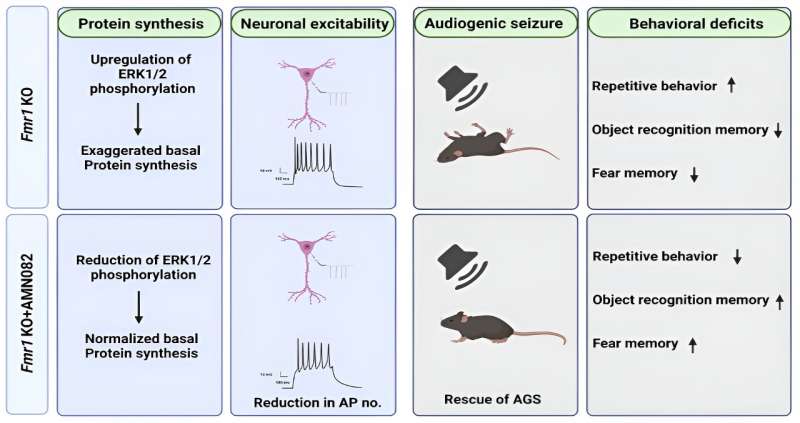This article has been reviewed according to Science X's editorial process and policies. Editors have highlighted the following attributes while ensuring the content's credibility:
fact-checked
trusted source
proofread
Research team uncovers novel receptor function in fragile X syndrome

Fragile X syndrome is one of the most commonly inherited forms of autism and intellectual disability, and no treatment currently exists. But a team of University of Illinois researchers led by Vipendra Kumar, a postdoctoral researcher in the Department of Molecular & Integrative Physiology, has discovered a novel receptor function that may be used in a therapeutic approach to treatment.
Their findings, published in EMBO Molecular Medicine, shed light on the ability of a metabotropic receptor known as mGluR7 to reduce protein synthesis. Individuals with fragile X syndrome lack expression of the ribonucleoprotein FMRP, which limits protein production. Because their brain lacks FMRP, translation is upregulated, resulting in excess protein. This is reflected in molecular and behavioral abnormalities.
In a mouse model of fragile X, mice deficient in FMRP were more susceptible to seizures and exhibited decreased neuroplasticity and working memory. Previous attempts to treat fragile X syndrome have centered on rebalancing elevated protein synthesis by inhibiting mGluR5, a member of group I mGluR metabotropic glutamate receptors (mGluRs).
Kumar and colleagues discovered that activation of mGluR7 using the positive allosteric modulator AMN082 reduced protein synthesis in the mice, resulting in improved memory and learning as well as significant decreases in both neuronal excitability and audiogenic seizures.

"It is known that significantly elevated protein synthesis causes neuronal processing defects," Kumar said. "In our research, we have tried to discover the involvement of other kinds of metabotropic glutamate receptors (mGluRs). We discovered a novel function of mGluR7 as a regulator of protein synthesis; activating this receptor significantly reduced protein synthesis while also mitigating other symptomatic phenotypes in the fragile X syndrome mice."
The findings came as a welcome surprise.
"We wanted to understand the underlying mechanisms of the disease, and the original project involved a completely different receptor, mGluR5," said Nien-Pei Tsai, an associate professor of Molecular & Integrative Physiology at the university and the senior author on the study. "But we found that mGluR7 tends to have the opposite effect of mGluR5. It actually helped reduce protein synthesis."
Identifying a potential therapeutic approach for fragile X is an exciting development in the study of the disease, but the research will not stop there. One disadvantage of AMN082 as a modulator is its limited bioavailability. Kumar is planning on collaborating with campus chemists to create a more stable activation source specific towards mGluR7 that may become a future therapeutic avenue.
Kumar and other members of the Tsai lab will continue to study fragile X syndrome to understand what other aspects are regulated by mGluR7, such as circadian rhythm and sleep, neuronal excitability, and hippocampal function. Their advances will contribute to further understanding of inherited autism disorders.
"With most autism, we don't know what's going on in the brain in terms of genes," Tsai said. "But with our findings of mGluR7 in fragile X syndrome, I believe we are one step closer to understanding what happens in other autism spectrum disorders."
More information: Vipendra Kumar et al, mGluR7 allosteric modulator AMN082 corrects protein synthesis and pathological phenotypes in FXS, EMBO Molecular Medicine (2024). DOI: 10.1038/s44321-024-00038-w

















